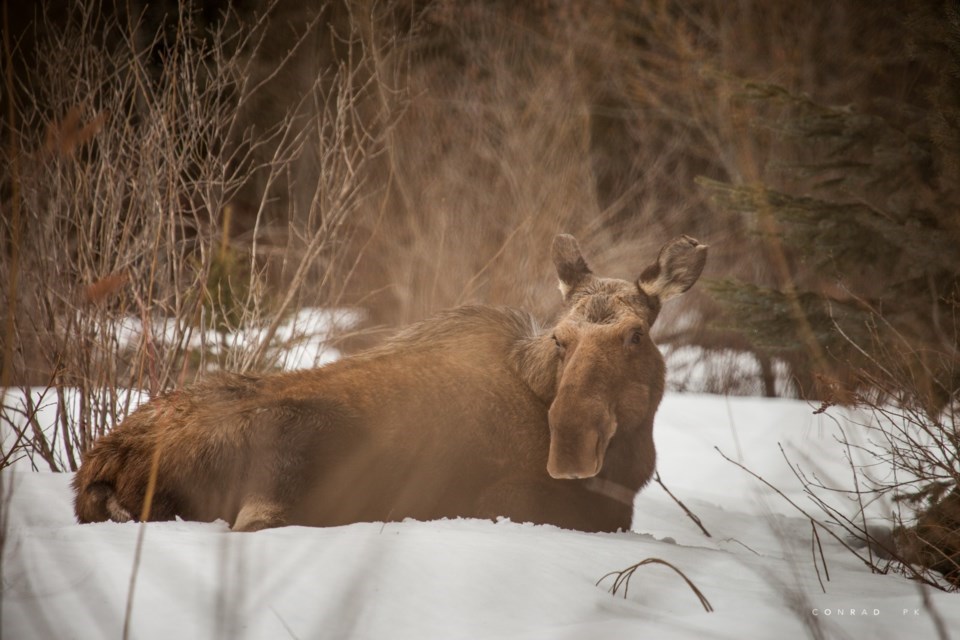Sometimes it’s difficult to sum up Whistler’s paradoxical existence as a town of nature lovers that’s also a commercial mountain resort hosting millions of tourists every year, but there’s one story I think sums it up perfectly: that time we killed a moose.
The year was 2013. The month was March. There was still ankle-deep snow on the ground around the village and temperatures at night were well below freezing.
A wayward female moose had somehow found its way into the small wetland between Blackcomb Way and Fitzsimmons Creek. Someone spotted it, word got out on social media, and moose fever briefly hit the town of Whistler.
Almost immediately, vehicles were lined up and down the road as both locals and visitors headed to the area to get pictures. People reportedly travelled all the way up from the city for the day just to show her to their kids.
While the valleys around Whistler do have moose, it’s rare to see them around town aside from the occasional loner passing through. Moose are shy around people, so a moose clearly visible from the road was too good to pass up.
Conservation officers posted signs asking people to stay away. There had been issues with unleashed dogs chasing the moose and people getting too close with their cameras. They were concerned the moose would be too distressed to leave the wetland with people hemming it in.
The signs were ignored. The newspaper story I wrote telling people to stay away was also ignored, and may even have made things worse as more people found out about her.
The show went on for two full weeks. The moose arrived healthy, but then started losing weight. It was wet and cold all the time and had stopped eating. At that point, the conservation officers felt they had no choice but to intervene—hit the moose with a tranquilizer dart and then move it somewhere safely away from people.
In the words of the conservation officer: “People continue to ignore the advice provided in the previous media release. Members of the public have been entering the wooded area and searching for the moose, and attempting to view the moose and get photos. Motorists have also been causing traffic jams while pedestrians are walking back and forth across the road to get photos.”
The moose stayed on its feet for three minutes after being darted, then stumbled into a pool of water. Conservation officers got to her before she could drown, then moved her to an undisclosed area to the north of Whistler where she was released. They watched until she regained consciousness.
The officers came back the next day to check on her status and found her body in a ditch on the side of the road.
Oh, and she was pregnant—so technically I guess you could say we killed two moose.
I think about that poor moose all the time, and how people placed their own selfish need to see her—to experience the nature she represented—over her needs. People were asked to leave her alone so she could move along, but they couldn’t. They wouldn’t. We loved that moose to death.
She wasn’t the first animal killed by our mountain paradox, and she won’t be our last.
Take our embattled bears. Every year, bears are killed when they get too comfortable around people and our food sources, and become a safety risk.
The last few years there have been two mothers with three curious cubs each in the south end of town. The hungry cubs climbed onto balconies, broke into cars, ransacked barbecues, and did what was necessary to survive a hot summer where the berries never really arrived, the creeks dried up, and the grass and dandelions went brown early.
The last I heard, at least three and possibly four of those cubs were hit and killed by vehicles. Another yearling was limping around my neighbourhood last year before it disappeared.
I get it, nature is brutal. But we’re not really part of that nature anymore, and our existence makes life even more tenuous for wild animals.
One of the reasons so many of us moved to the mountains is the fact we get to be up close and personal with real wilderness, even when we should be keeping our distance. In many ways we take our nature for granted.
We need to drive better and expect animals on our roads at any time—especially at night when they’re difficult to see. We need to take far more care to ensure there are no bear attractants around us that could put them at risk.
At the same time, Whistler is growing. Green spaces are getting smaller. Wildlife corridors are being broken up. There are more cars on more roads. There are more domesticated dogs chasing birds and barking at wildlife. There are more outdoor cats hunting all kinds of native species at night. Humans are pushing out nature on every front.
Everybody wants a whiskey jack to land on their upraised ski pole, but since those signs went up and we stopped feeding them we’re just making the few that are left burn through their stored energy reserves, flying from pole to pole with no food reward to show for it.
That’s the whole paradox. We love our wild animals, but we’re not very good at putting their needs ahead of ours. That needs to change.




